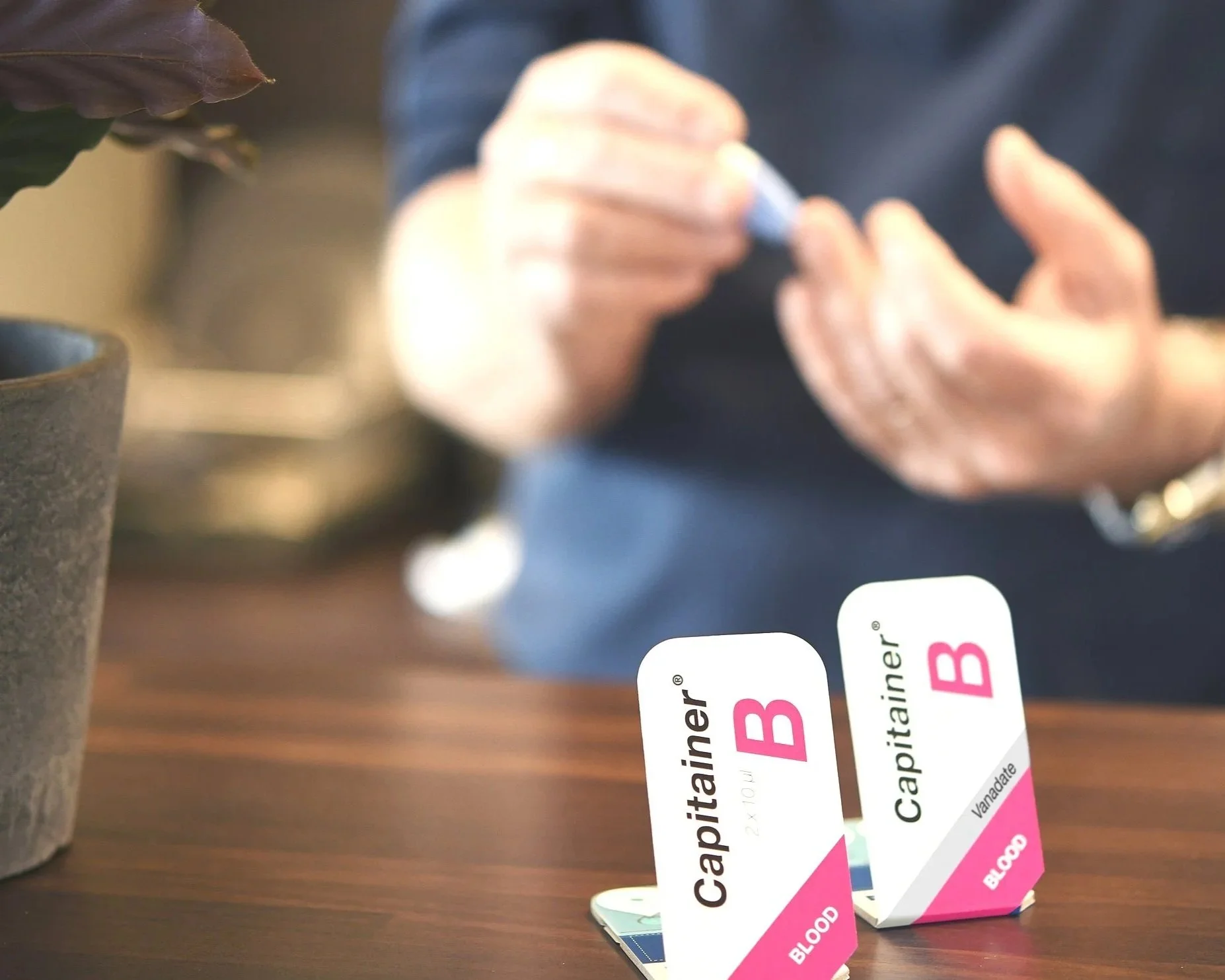
Managing your HbA1c levels is a key part of maintaining good health, especially for those with diabetes or at risk of developing it.
Our goal is to provide clear, reliable, and accessible information to help you understand what HbA1c is, why it matters, and how you can take control of your health.
A fingerprick test at home benefits the participant by providing a quick, convenient, and minimally invasive way to monitor their health without needing a clinic visit. It allows for accurate results, enabling timely decisions about medical care while reducing costs and the hassle of frequent lab appointments. This method is especially useful for individuals managing chronic conditions like diabetes or high cholesterol, as it supports regular monitoring with minimal discomfort.
Definition
Hemoglobin A1c (HbA1c) is a specific type of hemoglobin that becomes chemically bonded to glucose in the bloodstream. This process allows HbA1c levels to serve as a marker for how much glucose has been circulating in the blood over the past 2 to 3 months.
Because of this, HbA1c is an important tool used in diagnosing diabetes and prediabetes, and it’s also crucial for monitoring how well people with diabetes are managing their blood sugar over time
About HbA1c
HbA1c an important indicator of diabetes?
High HbA1c levels indicate poor blood sugar control, which increases the risk of developing complications such as cardiovascular disease, kidney damage, nerve damage, and vision problems in people with diabetes.
For most people with diabetes, a target HbA1c level is usually less than 53 mmol/mol (equivalent to less than 7.0% in percentage). However, this target may vary depending on individual factors like age, type of diabetes, and comorbidities. Managing HbA1c effectively can help reduce the risk of diabetes-related complications.
How is HbA1c measured and what are the typical ranges?
HbA1c is typically measured through a blood test, and in our case, it is measured using innovative technology involving a dry blood card. A single drop of blood is placed on the specially designed paper, where it dries.
Ranges are as follows:
Normal range: Less than 42 mmol/mol (equivalent to less than 6.0% in percentage).
Pre-diabetes (Increased risk): Between 42 mmol/mol and 47 mmol/mol (equivalent to 6.0% to 6.4% in percentage).
Diabetes: 48 mmol/mol or higher (equivalent to 6.5% or higher in percentage).
Prevalence of Diabetes and HbA1c in Sweden
As of recent estimates, over 550 000 people in Sweden are living with diabetes, and around 200 000 people living with undiagnosed diabetes.
Improving HbA1c management is a critical area of focus to reduce long-term healthcare costs and improve the quality of life for those affected.
Routine HbA1c testing is key for early diagnosis and better management of diabetes, helping to mitigate risks and avoid complications. Regular check-ups and lifestyle changes can play a significant role in managing the disease.
FAQs
-
How old does a child have to be to take an at-home HbA1c test?
Children should be at least 2 years old to perform the test at home using our HbA1c kit.How old does a child have to be to take a sample using a finger prick for the test?
Finger prick testing can be used for children ages 2 and upHow quickly should I post my samples after taking a blood sample?
We recommend posting your sample within 24 hours of collection to ensure the most accurate results.Do I need to fast before I take my HbA1c test?
No, fasting is not required before taking the HbA1c test.
What is the best method to get enough blood from your finger for a home test kit?
To get an optimal sample, ensure your hands are warm and hydrated. Gently massage your hand before pricking, and be sure to follow the kit instructions for the best collection method.
-
How do I book a test and how does it work?
To order your at-home HbA1c test kit, simply visit our “Get started” page, select the test, and we will send the kit directly to you.When will I receive the HbA1c I have ordered online?
Orders for at-home testing kits typically ship within xxx working days. Delivery time will depend on your location.Can I place an order over the phone?
Unfortunately, we only accept orders through our website for our at-home testing kits.
-
Who can I contact if there’s a delay?
If there’s a delay with your order or sample, please contact our customer support team via info@firstwellnesstesting.com.Will I get another kit sent to me if I cannot fill up the device correctly?
If you experience any difficulty in collecting the sample, contact us and we will discuss options with you.Will my results ever be delayed?
Results are usually processed within 2 working days after the lab receives your sample. However, delays can occasionally occur due to high demand or issues with the sample quality.Result interpretations
-
Capitainer®B 10 is a CE-IVD (IVDR) product registered according to the IVD Regulation (EU) 2017/746. The product is registered with FDA as a Device Class 1. In other regions, where above registrations does not apply, the device is supplied as a research use only (RUO) product for research and non-diagnostic activities. End-users and laboratories are responsible for validating the assay results from Capitainer® products.

